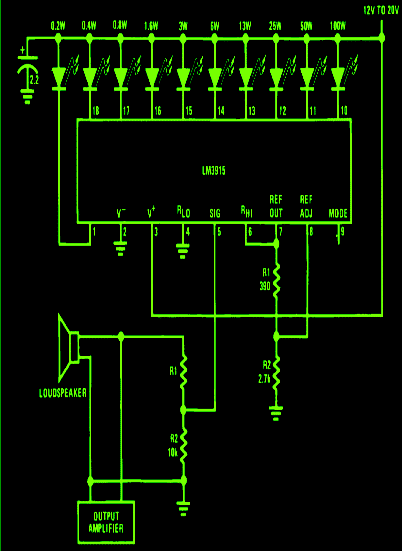Music Amplifiers have always intrigued us due to their massive amplifying capabilities which completely changes the dimensions of the delivered music outputs. Fundamentally it's the power of the amplifier that's always on the scanner and we find folks getting too obsessed by the power rating of their procured amplifier unit.
Introduction
However many of us completely fail to understand the technicalities of the above parameters and blindly agree to the manufactures spec sheet while buying an amplifier unit.In this article I will explain a very straight forward circuit which can be easily built at home and used for determining the power of an amplifier output.
Here the proposed amplifier power meter circuit utilizes the magnificent IC LM3915 from TEXAS INSTRUMENTS, which takes the center stage and solely functions to convert the input from an amplifier to a direct LED readout, indicating the instantaneous power output levels.
How the Circuit Functions
The input to the IC is derived via a potential divider network R1/R2 built across the loudspeaker, connected to the amplifier.
The proposed design provides a maximum readout of 100 watts, however the circuit may be quickly modified for enabling higher readouts by adjusting the value of R2.
The LEDs begin sequencing in response to the varying power output from the speaker.
Through some careful inspection of the readouts, the average intermediate LED display may be identified and the respective marking of the LED may be noted as the RMS value of the amplifier, however that might be relevant to the particular set volume level.

Engineer… as always, many thanks…
1. Up to how much power could it measure with the modification… Only R2.?
2. What would be the modification to measure the maximum power.
3. Could use as a visual meter on an amplifier.
Thank you Felix,
Yes you can measure any range of power simply by modifying the R2 value….or by replacing R2 with a preset or potentiometer.
I don’t want to temper wit ur rated calibratn. I need it as u stated. 0.2w to 100w
you will need to calibrate it using a 100K pot
Waoo I love this… I hv 2nos this ic since 4years ago I use 1for battery check 2nd one not in use.
I ll build it but u forgot to add the value of R1.since u hv calibrated the cct. what’sd value of R1? thanks in advance
Thanks jesubiyi, you can use 100K pot with a 10K resistor for R1, this can be adjusted for getting the correct calibration across LED bar graph